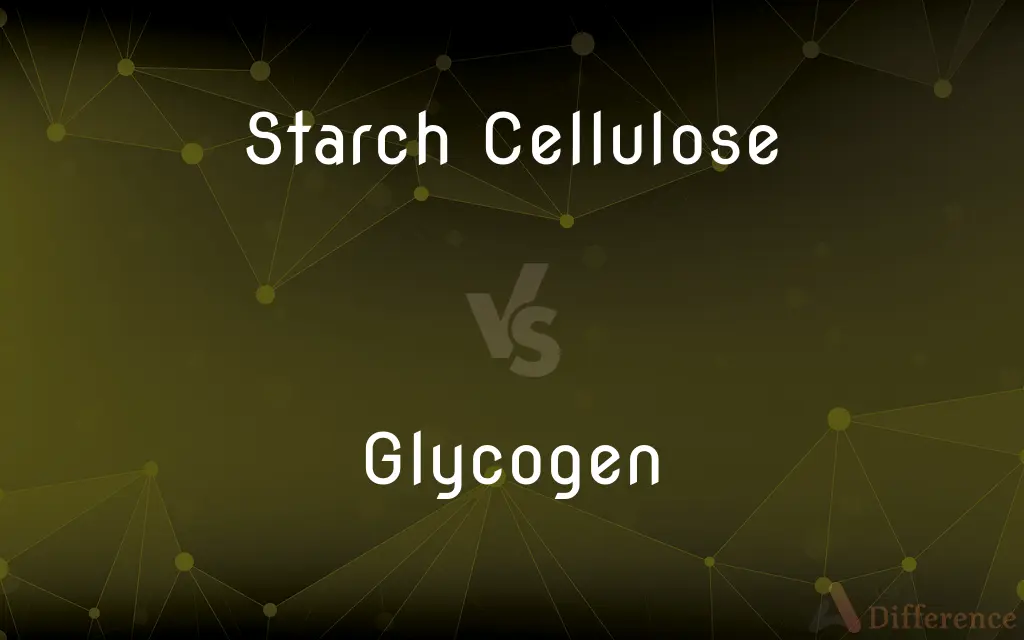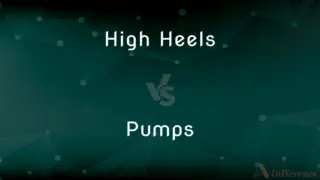Starch Cellulose vs. Glycogen — What's the Difference?
Edited by Tayyaba Rehman — By Fiza Rafique — Published on December 2, 2023
Starch Cellulose vs. Glycogen: Starch Cellulose is a plant polysaccharide, indigestible by humans; Glycogen is an animal storage carbohydrate.

Difference Between Starch Cellulose and Glycogen
Table of Contents
ADVERTISEMENT
Key Differences
Starch Cellulose is the main constituent of plant cell walls, providing structure to the plant. Glycogen, on the other hand, is the primary storage form of energy in animals, stored primarily in the liver and muscles.
While Starch Cellulose is a linear polymer of glucose units with some branching, Glycogen is highly branched. This branching in Glycogen allows for rapid glucose release when energy is needed.
Starch Cellulose, being a major component of plant fibers, is not digestible by human enzymes. In contrast, Glycogen can be readily broken down by enzymes in animals to provide glucose.
Humans consume Starch Cellulose indirectly as dietary fiber which aids in digestion. Glycogen, on the other hand, is consumed when we eat animal products.
While both Starch Cellulose and Glycogen play vital roles in their respective organisms, their function and structure are distinct, reflecting their unique roles in plants and animals.
ADVERTISEMENT
Comparison Chart
Origin
Found in plants
Found in animals
Structure
Linear with some branching
Highly branched
Digestibility
Indigestible by humans
Digestible and used for energy
Role
Provides structure to plants
Energy storage in animals
Consumption by Humans
As dietary fiber
When eating animal products
Compare with Definitions
Starch Cellulose
A glucose polymer in plants.
Starch Cellulose is made of numerous glucose units bonded together.
Glycogen
An animal's primary carbohydrate reserve.
After a meal, excess glucose in the body is stored as Glycogen.
Starch Cellulose
Indigestible fiber for humans.
Humans can't digest Starch Cellulose, so it passes through the digestive system.
Glycogen
Provides quick energy for animals.
When an animal needs a burst of energy, it breaks down Glycogen.
Starch Cellulose
Provides rigidity to plants.
Thanks to Starch Cellulose, plants stand tall and sturdy.
Glycogen
A highly branched glucose polymer.
The structure of Glycogen allows for quick release of glucose when needed.
Starch Cellulose
A polysaccharide forming the cell walls of plants.
In the plant's cell wall, you'll find a high content of Starch Cellulose.
Glycogen
Depleted with intense exercise.
Marathon runners often talk about hitting the wall when Glycogen stores are low.
Starch Cellulose
The main component of wood and paper.
Wood's strength is attributed to its Starch Cellulose content.
Glycogen
Stored mainly in the liver and muscles.
The liver has significant stores of Glycogen to regulate blood sugar levels.
Glycogen
A polysaccharide, (C6H10O5)n, that is the main form of carbohydrate storage in animals and is found primarily in the liver and muscle tissue. It is readily converted to glucose as needed by the body to satisfy its energy needs. Also called animal starch.
Glycogen
(carbohydrate) A polysaccharide that is the main form of carbohydrate storage in animals; converted to glucose as needed.
Glycogen
A white, amorphous, tasteless substance resembling starch, soluble in water to an opalescent fluid. It is found abundantly in the liver of most animals, and in small quantity in other organs and tissues, particularly in the embryo. It is quickly changed into sugar when boiled with dilute sulphuric or hydrochloric acid, and also by the action of amylolytic ferments.
Glycogen
One form in which body fuel is stored; stored primarily in the liver and broken down into glucose when needed by the body
Common Curiosities
How does the body use Glycogen?
The body breaks down Glycogen to release glucose for energy.
Where is Glycogen primarily found in animals?
Glycogen is mainly stored in the liver and muscles.
What is Starch Cellulose's primary role in plants?
Starch Cellulose provides structure and rigidity to plants.
How does Glycogen support intense physical activity?
During intense exercise, the body uses Glycogen stores for energy.
Why is Starch Cellulose important for the paper industry?
Starch Cellulose is the main component of wood, which is used to make paper.
What happens when the body's Glycogen stores are depleted?
When depleted, the body starts using fat for energy, which can be less efficient.
How is Starch Cellulose different from other plant polysaccharides?
Unlike other plant polysaccharides, Starch Cellulose is linear with some branching and indigestible by humans.
Is Starch Cellulose the same as starch in food?
No, while both are plant polysaccharides, food starch is digestible, but Starch Cellulose is not.
Why is Glycogen called an animal starch?
Because it serves a similar energy storage role in animals as starch does in plants.
Are there industrial uses for Starch Cellulose?
Yes, besides paper, Starch Cellulose is used in textiles, biofuels, and more.
Is Starch Cellulose beneficial for human health?
Yes, as dietary fiber, Starch Cellulose aids in digestion and supports gut health.
Can humans digest Starch Cellulose?
No, humans can't digest Starch Cellulose; it acts as dietary fiber.
How does the body replenish Glycogen stores?
Eating carbohydrates after exercise can help replenish Glycogen stores.
Share Your Discovery

Previous Comparison
Groupthink vs. Group Polarization
Next Comparison
High Heels vs. PumpsAuthor Spotlight
Written by
Fiza RafiqueFiza Rafique is a skilled content writer at AskDifference.com, where she meticulously refines and enhances written pieces. Drawing from her vast editorial expertise, Fiza ensures clarity, accuracy, and precision in every article. Passionate about language, she continually seeks to elevate the quality of content for readers worldwide.
Edited by
Tayyaba RehmanTayyaba Rehman is a distinguished writer, currently serving as a primary contributor to askdifference.com. As a researcher in semantics and etymology, Tayyaba's passion for the complexity of languages and their distinctions has found a perfect home on the platform. Tayyaba delves into the intricacies of language, distinguishing between commonly confused words and phrases, thereby providing clarity for readers worldwide.













































